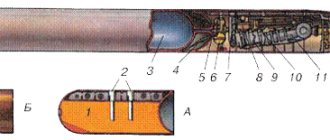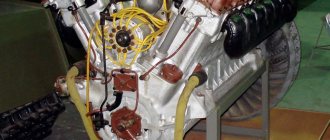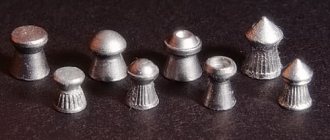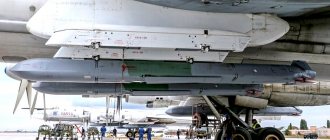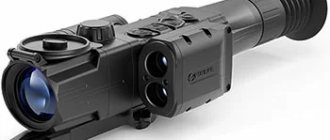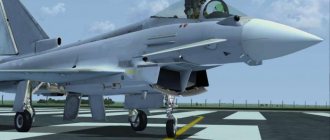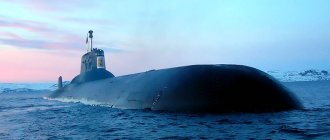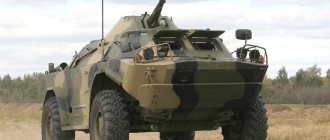Purpose
The universal deep-sea homing torpedo (UGST) is designed to destroy submarines, surface ships and vessels, as well as stationary targets.
Compound
- hardware module;
- combat charging compartment;
- tank compartment;
- power department;
- tail section;
- telecontrol coil.
Peculiarities
The UGST torpedo can be fired from 533 mm torpedo tubes located on submarines and NK. A basic modification of the torpedo with a length of 7.2 m can be included in the ammunition load of carriers with torpedo tubes of the Russian standard, and a modification with a length of 6.05 m can be included with torpedo tubes of the NATO standard. Compatibility of the onboard torpedo systems with the carrier systems is achieved by software configuration of the system unit in the process of binding to a given ship project. For placement on some modernized carriers, there are solutions that include the supply of a special pre-launch preparation transition console for entering data into the torpedo before firing.
A practical torpedo, used for personnel training and fleet preparation, is converted from a combat torpedo by replacing the combat charging compartment (BZO) with a practical compartment.
A distinctive feature of the UGST torpedo is its modular design with a multi-level modifiability potential (from reprogramming the equipment of the base model of the torpedo to replacing its engine or tank compartment), which makes it possible to quickly customize the torpedo to meet the requirements that take into account specific application features.
The power plant of the UGST torpedo is based on an axial piston engine running on liquid single-component fuel. The low-noise water-jet propulsion system is directly connected to the engine, without a gearbox. A special feature of the hydrodynamic design of the torpedo are two-plane rudders: they are extended beyond the caliber of the torpedo after it exits the torpedo tube.
The combat charging compartment is a compartment with an insert capsule in which the explosive is placed. Modifications of BZO differ from each other in the composition of the explosive and its weight.
The head compartment of the UGST contains an equipment module (AM), which includes homing systems (HHS), telecontrol, motion control and other electronic systems. The active-passive type SSN uses a flat receiving-emitting antenna array with an adjustable viewing sector.
The basis of the AM architecture is the creation on board a torpedo of a single powerful reprogrammable computing core that combines the information parts of on-board systems into a single information space using integrated control systems technology.
US Navy nuclear torpedoes and depth charges
In 1963, the long-range, high-speed, traceless anti-submarine torpedo Mk-45 “Astor” was adopted by the US Navy. In 1976, it was withdrawn from service due to the arrival of the Mk-48 torpedo in conventional equipment into the Navy.
In 1952, the USA developed the Mk-90 “Betty” aviation nuclear depth charge. The bomb was intended for use as an anti-submarine weapon for the US Navy. It was equipped with a W7 nuclear charge with a power of 32 kt, its weight was 509 kg, length - 3.1 m, diameter - 0.8 m. In 1959, a plane with a Mk-90 bomb (not equipped with a nuclear charge) made an emergency landing in the Pacific ocean, the bomb was lost and never found. By 1960, all Mk-90 bombs were removed from service.
For anti-submarine defense purposes, the Mk-101 “Lulu” aircraft depth charge was created in the 1950s. It was equipped with a W34 nuclear charge, the power of which was 11 kt. The dimensions of the bomb were: length - 2.3 m, diameter - 0.45 m, weight - 544 kg. Bomb production (in 5 modifications) took place from June 1958 to September 1962 (a total of 600 bombs were manufactured), and deployment to the US Navy from 1958 to 1971. The Mk-101 bomb was withdrawn from service in 1965.
Read: Design of the Ruger GP 100 revolver
Around the same years, another bomb was created - the Mk-105 "Hotpoint", also equipped with a W34 nuclear charge. It was developed for US Navy aviation and was the first bomb that provided detonation with a time delay (Laydown) after falling to the ground, which made it possible to use it from low altitudes (subsequently, this detonation mode was provided by the automatic system of aviation nuclear bombs Mk-43, Mk -41, Mk-53). To ensure the Laydown mode, the bomb was equipped with a 12.5-inch parachute, and the use of a timer provided both an air and underwater explosion. It was also the first modular bomb. The modular design of the bomb made it possible to change its overall dimensions, which made it possible to use it from various types of aircraft, both from external and internal slings.
The Mk-105 bombs of the first modification were put into service in 1958, the second modification - in 1960. All modifications of these bombs were withdrawn from service in 1964.
You might be interested:
- US anti-submarine missiles
- Nuclear mines (land mines) USA
- Nuclear weapons of US heavy bombers
- US missile aviation nuclear weapons
- US anti-aircraft missile systems and anti-missile systems
- American hydrogen bomb Mk 53 (B53)
Subscribe to
our channel in Yandex.Zen
Combat use
This type of torpedoes proved to be an effective weapon, one hit was enough to disable a cruiser-class ship for at least six months, two torpedoes meant very heavy damage or death, three left virtually no chance for the ship to survive[1]. In total, during the war years, these torpedoes sank 23 Allied ships, including 1 aircraft carrier, 11 cruisers and 11 destroyers. Another 13 were seriously damaged and needed to be repaired for a long time[2].
Battle in the Badung Strait:
- The Dutch destroyer Piet Hein was sunk on February 19, 1942 by torpedoes from the destroyer Asashio.
Battle of the Java Sea:
- The Dutch light cruisers De Ruyter and Java were finished off on February 27, 1942 by torpedoes from the cruisers Haguro and Nati.
- The Dutch destroyer Kortenaar was sunk on February 27, 1942 by torpedoes from the cruiser Haguro. Battle in the Sunda Strait: The Australian light cruiser Perth was sunk on March 1, 1942 by torpedoes from the cruisers Mogami and Mikuma.
- The American heavy cruiser Houston was sunk on March 1, 1942 by torpedoes from the cruisers Mogami and Mikuma.
Second Battle of the Java Sea:
- The British cruiser Exeter was sunk on March 1, 1942 by torpedoes from the destroyer Ikazuchi.
Battle of Savo Island:
- The Australian heavy cruiser Canberra and the American Quincy were finished off on August 9, 1942 by torpedoes from the cruisers Aoba, Kako, Kinugasa and Furutaka.
Battles for the Solomon Islands:
- The American destroyer Blue was sunk on August 22, 1942 by torpedoes from the destroyer Kawakaze.
Battle of the Santa Cruz Islands:
- On October 26, 1942, the American aircraft carrier Hornet was finished off by torpedoes from the destroyers Akigumo and Makigumo.
Naval Battle of Guadalcanal:
- The American light cruiser Atlanta was finished off by torpedoes from the destroyer Akatsuki on November 13, 1942.
- The American destroyers Barton, Laffey, Walk and Benham were sunk by destroyer torpedoes on November 13, 1942.
Battle of Tassafaronga:
- The American heavy cruiser Notrehampton was finished off by torpedoes from the destroyer Oyashio on October 30, 1942.
Battle of Kula Bay:
- The American destroyer Strong was sunk on July 5, 1943 by destroyer torpedoes.
- The American light cruiser Helena was sunk on July 5, 1943 by torpedoes from the destroyers Suzukaze and Tanikaze.
Battle of Kolombangara:
- The American destroyer Guin was heavily damaged by a torpedo on July 12, 1943 and was later sunk.
Battle near the island of Vella Lavella:
- The American destroyer Chevalier was sunk by the destroyer Yugumo on October 6, 1943.
Battle of Ormoc Bay:
- The American destroyer Cooper was sunk on December 3, 1944 by the destroyer Take[3]
Torpedoes and torpedo tubes
Torpedoes and torpedo tubes
The torpedoes used by American destroyers during World War II were sophisticated weapons. Various models were used, but the best at the beginning of the war was the 533 mm steam-gas torpedo. She weighed 2,215 pounds and cost about $10,000.
After launch, complex mechanisms kept the torpedo at a given depth, and it independently walked towards the target. The 533 mm torpedo could travel 4,500 yards at a speed of 46 knots. It can be thought of as a miniature self-steering submarine that carries a charge of 500 pounds of TNT. In later models the charge was increased to 1,100 pounds of torpex. This wonderful means of destruction has only one drawback. It misses the mark too often.[8]
Early in the war, American submarines and destroyers discovered that the depth setting mechanism too often had glitches that caused the torpedo to go deeper than required. When this deficiency was eliminated, the problem of fuze failure arose. The Navy adopted and transferred to destroyers at the end of 1941 a proximity magnetic fuse. It was assumed that the explosion would occur under the keel of an enemy ship or directly under the boules under the influence of the target's magnetic field. Such an explosion should have caused much more severe damage than a direct hit on the side.
But, unfortunately, the magnetic fuse turned out to be too crude. Possessing high sensitivity, it often worked without reaching the target, without causing any damage at all. In addition, the unsealed design allowed water to penetrate into the fuze, and it would not fire at all. The fine settings of the fuse were often lost when the torpedo, after leaving the apparatus, hit the water. It is interesting that the Nazis, who were the first to adopt magnetic fuses, abandoned them back in 1939 as unreliable and returned to conventional contact fuses. After months of painful setbacks, the US Navy abandoned the magnetic fuse. (On July 24, 1943, Admiral Nimitz, Commander-in-Chief of the Pacific Fleet, ordered the removal of all magnetic fuses from torpedoes.)
In other respects, American torpedoes also did not stand out. The Japanese have made a big leap in the development of torpedo weapons. In 1933, their engineers created a torpedo that used oxygen-enriched fuel. And then the Japanese switched to torpedoes with pure oxygen. During the war they used a 610mm torpedo that could travel 6,000 yards at 49.2 knots. It had a charge of 1,210 pounds of explosives - twice as much as an American 533 mm torpedo. By the end of the war, the Japanese had created a torpedo that had a range of 22,000 yards. These oxygen monsters were virtually untraceable.[9]
Compared to them, American torpedoes looked pathetic. But the sailors of the destroyer forces of the American fleet did everything they could. Before the end of the war, the Bureau of Armaments created an electric torpedo, and work began on acoustic homing torpedoes. These models proved very valuable to submariners, but active destroyer operations ended before they were built. After the Battle of Leyte, American destroyers were no longer able to launch a torpedo attack. The reason for this was the lack of goals. By this time, the Pacific Ocean had been, as they say, swept clean. The destroyer itself has also changed. It was created as a carrier of torpedo weapons, and now began to perform the more important functions of a submarine hunter and an air defense ship.
The standard torpedo tube of American destroyers was a package of several tubes installed on the deck in the middle part of the hull. On old destroyers, the devices were located on the sides, but on new ones they were located in the center plane. The modern apparatus had 5 pipes. The installation rotated automatically, was aimed from the central post, and a shot was fired from there. Torpedoes could be fired individually or in one gulp. Having 2 such devices, the destroyer could fire a salvo of 10 torpedoes.
